How to Connect a Smart Door Lock to Wi-Fi
Smart door locks offer convenience, remote access, and enhanced security—but only if they’re properly connected to your Wi-Fi network. Whether you’ve just purchased a Wi-Fi Smart Lock, setting it up correctly ensures seamless operation and reliable home security.
This guide walks you through the entire process, from pre-installation checks to troubleshooting common issues. By the end, you’ll be able to control your smart lock from anywhere using your smartphone, voice assistants, or even smart home hubs like Google Home or Amazon Alexa.
1. Pre-Installation: What You Need Before Connecting
Before diving into setup, make sure you have everything ready for a smooth installation:
Essential Tools & Requirements
A Stable Wi-Fi Network – Your smart lock needs a strong 2.4 GHz Wi-Fi signal (most don’t support 5 GHz). Check your router settings if unsure.
Smartphone & Manufacturer’s App – Download the lock’s companion app.
Fresh Batteries – Most smart locks run on AA or lithium batteries; weak power can cause connectivity issues.
Compatible Smart Home Hub (Optional) – If your lock supports Zigbee or Z-Wave, you may need a hub like Samsung SmartThings or Hubitat.
Positioning Your Router for Best Performance
- Place your router within 15-20 feet of the lock for a strong signal.
- Avoid thick walls or metal obstructions that weaken Wi-Fi.
- If the signal is weak, consider a Wi-Fi extender (like TP-Link or Eero).
Once everything is ready, proceed to the installation.
2. Step-by-Step Wi-Fi Connection Guide
The exact steps vary slightly by brand, but the general process is similar for most smart locks.
Step 1: Install the Lock & Power It On
- Follow the manufacturer’s instructions to mount the lock on your door.
- Insert fresh batteries and ensure the lock is powered.
Step 2: Download & Open the App
- Search for your lock’s app in the App Store (iOS) or Google Play (Android).
- Create an account if required.
Step 3: Put the Lock in Pairing Mode
- Most locks require you to press a button (often on the interior side) to enter setup mode.
- Some models use Bluetooth for initial setup before switching to Wi-Fi.
Step 4: Connect to Wi-Fi
- In the app, go to Settings > Wi-Fi Setup.
- Select your 2.4 GHz network (avoid 5 GHz—most locks don’t support it).
- Enter your Wi-Fi password when prompted.
- Wait for the lock to confirm a successful connection (usually a green light or beep).
Step 5: Test Remote Access
- Walk away from your home and try locking/unlocking via the app to confirm Wi-Fi connectivity.
- If it works, your setup is complete!
Pro Tip: Some locks require a Wi-Fi Bridge for remote access—check if yours needs one.
3. Troubleshooting Common Wi-Fi Connection Issues
Even with careful setup, you might encounter connectivity problems. Here’s how to fix them:
Problem 1: Lock Won’t Connect to Wi-Fi
Solution:
- Restart your router and lock.
- Ensure you’re using 2.4 GHz Wi-Fi (not 5 GHz).
- Move the router closer or use a Wi-Fi extender.
Problem 2: Lock Disconnects Frequently
Solution:
- Check for interference (microwaves, baby monitors, etc.).
- Update the lock’s firmware via the app.
- Replace the batteries—low power can cause drops.
Problem 3: App Says “Device Not Found”
Solution:
- Reset the lock to factory settings and retry setup.
- Ensure your phone’s Bluetooth is on (needed for initial pairing).
If problems persist, contact the manufacturer’s customer support.
4. Enhancing Your Smart Lock’s Wi-Fi Performance
Once connected, optimize your setup for the best performance:
1. Enable Auto-Lock & Alerts
- Prevent accidental unlocks by setting an auto-lock timer.
- Get real-time notifications if someone enters.
2. Integrate with Smart Home Systems
- Connect to Alexa, Google Assistant, or Apple HomeKit for voice control.
- Set up automations (e.g., “Lock the door when I leave”).
3. Regularly Check Batteries & Updates
- Replace batteries every 6-12 months.
- Install firmware updates to patch security vulnerabilities.
4. Use a Guest Access Feature
- Generate temporary access codes for visitors instead of sharing your main PIN.
Final Thoughts: Enjoy Keyless Convenience with Reliable Wi-Fi
Connecting your smart lock to Wi-Fi unlocks its full potential—letting you control access remotely, monitor entries, and integrate with other smart devices. By following this guide, you’ll ensure a stable connection and avoid common pitfalls.
Now, whether you’re at work, on vacation, or just lounging on the couch, you’ll always know your door is secure. Happy smart locking!
Post time: May-09-2025


